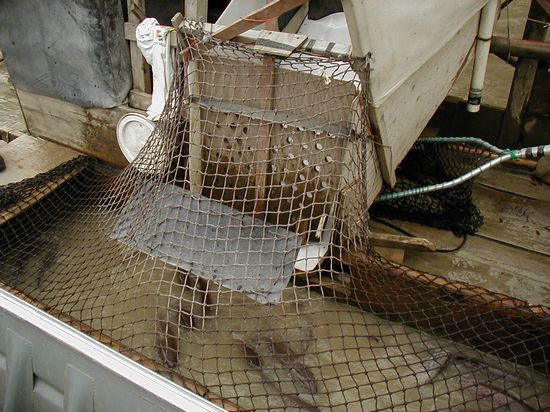|
|
||||||||||||||||||||||||||||
|
Click on to go to:* Daily Video Project Data Updates Above also found at: |
||||||||||||||||||||||||||||
|
Listen to
jojobishop@hotmail.com click picture to open |
||||||||||||||||||||||||||||
|
Contact |
||||||||||||||||||||||||||||
|
|
||||||||||||||||||||||||||||
|
From 1996 to 2005 the Rapids video fishwheel site was used to provide fish for the USFWS Rampart Rapids Fall Chum Salmon Tagging Project. In 1997, 1998 and 1999 a fall chum radio-tagging project was conducted by the National Marine Fisheries Service at this site. During the first year of operation the radio tag project became aware of a possible mortality problem with live box held chum salmon. This problem was studied in 1998 and 1999 and project results (not yet published) showed a significant negative effect on fish held in the live box for 4 to 6 hour (J. Eiler, National Marine Fisheries Service, personal communication). Since then a number of studies have been conducted and results published. After this picture of the live box attached to the video fish wheel at Rapids are some of the reports on further research into this issue at Rapids.
Abstract. (full report see below). - Since 1996, U.S. Fish and Wildlife Service biologists have annually used fish wheels to capture migrating adult fall chum salmon Oncorhynchus keta in the main-stem Yukon River, Alaska, and estimated their abundance via mark–recapture methods. In each year of the study, the mark rate of captured fish at a site near Rampart has been substantially greater than rates observed at numerous locations upriver of that site. The factors most likely to cause the observed reduction in the mark rate are violations of mark–recapture model assumptions or the mortality of marked fish between the Rampart site and upriver locations. Results of studies conducted through 2000 were most consistent with the hypothesis of mortality. We investigate potential explanatory factors for the apparent reduction in mark rates at upriver locations using data collected during additional studies from 2001 to 2003. Results document that holding fish in submerged pens at the marking site negatively affects their ability to migrate for at least some time. No evidence of tag loss or spatial segregation within the mark–recapture study area was observed. A conclusion that some aspect of the capture and handling of fish elevates their mortality upriver of the mark–recapture study area seems well founded. However, holding of fish does not solely explain the reduction in mark rates at upriver locations, and other contributing factors remain unidentified. Researchers using fish wheels should be aware that the gear may be more harmful to fish than was previously thought and may bias estimators of some parameters such as abundance or migration speed. Open a report for viewing by a left click on the report or download a copy by a right click and then select save target as) Capture Mortality and Effects Reports
|
| [Home] [Rapids Video Project] [Yukon River Panel] [Fish Friendly] [Video Equipment] [Reports] [Rapids Research Video] [Capture Mortality] [Related Projects] [Whitefish Reports] [Data] [Project History] [Current Issues] [Student Data Project] [Chum Tag Project] [Fish Links] [Fishwheels] [Subsistence Activities] [Commercial Fishing] |

